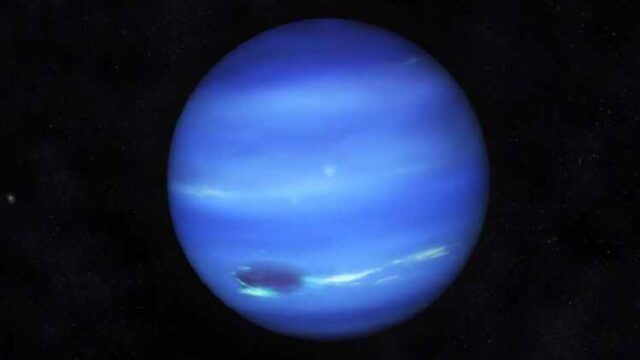Since 1989, when Voyager 2 passed by Neptune, the gigantic dark smudges that appear in the distant planet’s atmosphere have provided a strange puzzle.
For the first time, we have spotted one with Earth-based devices at extraordinary detail, which is assisting scientists in determining why those patches appear so dark and how they differ from spots on other planets.
“Since the first discovery of a dark spot, I’ve always wondered what these short-lived and elusive dark features are,” says Patrick Irwin of the University of Oxford in the United Kingdom.
“I’m overjoyed to have not only made the first detection of a dark spot from the ground, but also to have recorded a reflection spectrum of such a feature for the first time.”
The black vortices of Neptune are truly anticyclonic storms, similar to Jupiter’s Great Red Spot, but they differ in some important and puzzling ways. For starters, they are rather transient, forming and disappearing every few years.
They are also expected to have less cloud in their centers than storm vortex on Saturn and Jupiter. The clouds we see are fluffy white clouds that form around the edges, most likely as a result of gasses freezing into methane ice crystals as they rise from lower altitudes.
However, because to Neptune’s distance and the vortices’ short-lived nature, understanding anything more has proven difficult. The Hubble Space Telescope has been the only device capable of detecting and tracking them since 1994, limiting the wavelength range in which the planet can be viewed.
However, when a big storm vortex developed in 2018, Irwin and his team were able to use a different instrument: the Very big Telescope’s Multi Unit Spectroscopic Explorer (MUSE). MUSE was able to detect sunlight reflected off Neptune and divide it into its constituent wavelengths in order to reconstruct a 3D spectrum of the planet.
Because different wavelengths correspond to different elevations in Neptune’s atmosphere, the researchers were able to determine the altitude of the black patch. They discovered something unexpected: it did not appear to be a “hole” in Neptune’s atmosphere after all.
Rather, the deeper color appears to be the result of particle darkening in the layer of hydrogen sulfide beneath Neptune’s atmospheric aerosol cloud. The researchers believe this is due to local heating in the deep region of an anticyclonic vortex, which vaporizes the hydrogen sulfide ice, revealing a darker vortex core. The observations of the researcher are consistent with particles in the aerosol layer above getting smaller, reducing opacity.
They also discovered another surprise: a brilliant cloud accompanying the vortex. This was not one of the usual methane clouds that accompany Neptune vortex, but a new form of cloud. It appeared to be at the same altitude as the dark vortex, rather than higher in the atmosphere.
This will need to be examined further, as will if any of the team’s proposed explanations for Neptune’s atmospheric darkening are right. However, with the ability to see Neptune from Earth, we appear to be much closer to finding answers.
“This is an astounding increase in humanity’s ability to observe the cosmos,” says University of California, Berkeley astronomer Michael Wong.
“At first, we could only detect these spots by sending a spacecraft, such as Voyager, there.” Then, with Hubble, we were able to see them from afar. Finally, technology has advanced to the point where this is possible from the ground up.”

















